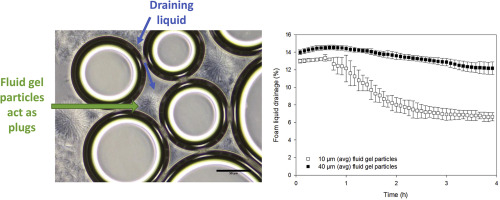当前位置:
X-MOL 学术
›
Food Hydrocoll.
›
论文详情
Our official English website, www.x-mol.net, welcomes your feedback! (Note: you will need to create a separate account there.)
The effect of sugars on agar fluid gels and the stabilisation of their foams
Food Hydrocolloids ( IF 10.7 ) Pub Date : 2019-02-01 , DOI: 10.1016/j.foodhyd.2018.08.027 A.L. Ellis , T.B. Mills , I.T. Norton , A.B. Norton-Welch
Food Hydrocolloids ( IF 10.7 ) Pub Date : 2019-02-01 , DOI: 10.1016/j.foodhyd.2018.08.027 A.L. Ellis , T.B. Mills , I.T. Norton , A.B. Norton-Welch

|
Abstract The rising demand to reduce sugar in foods has resulted in the need to better understand its structuring properties and contribution to the overall microstructure of products. The effect of sugars on the microstructure of agar fluid gels and their novel foams, including stability, has therefore been studied. Gelation kinetics and material properties of agar fluid gels with added glucose, fructose and sucrose have been explored. The addition of sugar did not notably affect the temperature of ordering during gelation however, it did cause a reduction in fluid gel particle size through changes in solution viscosity during gelation. At high concentrations of sugar (above 50%), the conversion of an overall brittle agar gel network to a more rubbery-like structure was inferred through rheology, as the glass transition of sugar was approached. Below 50% sugar, shear viscosity and G′ increased with concentration due to an increase in particle gel strength (observed through initial Young's modulus). These changes in material properties were overall observed to be independent of sugar type. All systems showed good foaming properties where foam half-life increased with sugar concentration as a result of increased fluid gel yield stress. In order to increase understanding of the foam stability mechanism, fluid gel particle size was altered. When the continuous phase consisted of larger particles, the initial liquid drainage was considerably reduced as particles were more effective at accumulating in the foam channels preventing the flow of the bulk phase. However, foam half-life was ultimately dependent on fluid gel yield stress. This research has provided fundamental understanding of the effect of sugars on the microstructure of agar fluid gels and their use in foam stabilisation, allowing the development of an approach that can potentially be tailored to specific product requirements.
中文翻译:

糖对琼脂流体凝胶的影响及其泡沫的稳定性
摘要 减少食品中糖分的需求不断增加,导致需要更好地了解其结构特性和对产品整体微观结构的贡献。因此,研究了糖对琼脂流体凝胶及其新型泡沫(包括稳定性)的微观结构的影响。已经探索了添加葡萄糖、果糖和蔗糖的琼脂流体凝胶的凝胶动力学和材料特性。糖的添加不会显着影响胶凝过程中的有序温度,但是,它确实通过胶凝过程中溶液粘度的变化导致流体凝胶粒径减小。在高浓度的糖(超过 50%)下,随着糖的玻璃化转变接近,通过流变学推断整体脆性琼脂凝胶网络转化为更像橡胶的结构。由于颗粒凝胶强度的增加(通过初始杨氏模量观察),低于 50% 的糖,剪切粘度和 G' 随浓度增加而增加。总体上观察到材料特性的这些变化与糖类型无关。所有系统都显示出良好的发泡特性,其中泡沫半衰期随着糖浓度的增加而增加,这是流体凝胶屈服应力增加的结果。为了增加对泡沫稳定性机制的理解,改变了流体凝胶粒度。当连续相由较大的颗粒组成时,初始液体排放显着减少,因为颗粒更有效地积聚在泡沫通道中,阻止了本体相的流动。然而,泡沫半衰期最终取决于流体凝胶屈服应力。
更新日期:2019-02-01
中文翻译:

糖对琼脂流体凝胶的影响及其泡沫的稳定性
摘要 减少食品中糖分的需求不断增加,导致需要更好地了解其结构特性和对产品整体微观结构的贡献。因此,研究了糖对琼脂流体凝胶及其新型泡沫(包括稳定性)的微观结构的影响。已经探索了添加葡萄糖、果糖和蔗糖的琼脂流体凝胶的凝胶动力学和材料特性。糖的添加不会显着影响胶凝过程中的有序温度,但是,它确实通过胶凝过程中溶液粘度的变化导致流体凝胶粒径减小。在高浓度的糖(超过 50%)下,随着糖的玻璃化转变接近,通过流变学推断整体脆性琼脂凝胶网络转化为更像橡胶的结构。由于颗粒凝胶强度的增加(通过初始杨氏模量观察),低于 50% 的糖,剪切粘度和 G' 随浓度增加而增加。总体上观察到材料特性的这些变化与糖类型无关。所有系统都显示出良好的发泡特性,其中泡沫半衰期随着糖浓度的增加而增加,这是流体凝胶屈服应力增加的结果。为了增加对泡沫稳定性机制的理解,改变了流体凝胶粒度。当连续相由较大的颗粒组成时,初始液体排放显着减少,因为颗粒更有效地积聚在泡沫通道中,阻止了本体相的流动。然而,泡沫半衰期最终取决于流体凝胶屈服应力。



























 京公网安备 11010802027423号
京公网安备 11010802027423号